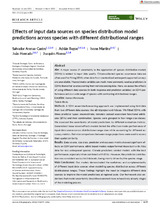Mostrar el registro sencillo del ítem
Effects of input data sources on species distribution model predictions across species with different distributional ranges
| dc.contributor.author | Arenas Castro, Salvador | |
| dc.contributor.author | Regos, Adrián | |
| dc.contributor.author | Martins, Ivone | |
| dc.contributor.author | Honrado, João | |
| dc.contributor.author | Alonso, Joaquim | |
| dc.date.accessioned | 2024-03-20T09:50:41Z | |
| dc.date.available | 2024-03-20T09:50:41Z | |
| dc.date.issued | 2022 | |
| dc.identifier.uri | http://hdl.handle.net/10396/27711 | |
| dc.description.abstract | Aim: A major source of uncertainty in the application of species distribution models (SDMs) is related to input data quality. Citizen-collected species occurrence data are often used for fitting SDMs when data from standardized and expert-supported surveys are unavailable. Macroclimate variables are much more commonly used as predictors in SDMs than other sources coming from remote sensing data. Here, we assess the effects of using different data sources (in both response and predictor variables) on SDM per formance across a wide range of species with contrasting distributional ranges. Location: Iberian Peninsula. Taxon: Birds. Methods: A SDM ensemble-forecasting approach was implemented using bird data from two different data sources: the eBird project and Atlases. We fitted SDMs with three predictor types: macroclimate, remotely sensed ecosystem functional attrib utes (EFAs) and their combination. Species were grouped in four range size classes. We assessed the uncertainty of model predictions by different evaluation metrics. Generalized linear mixed-effects models tested the effect on model performance of input data source across distributional range sizes while accounting for different ac curacy metrics. Pairwise comparisons between range projections were used to assess their spatial similarity. Results: Data source, size class, predictor and accuracy metric showed significant ef fects on SDM performance. eBird-based models outperformed those built with Atlas data for less widespread species. Climate predictors yielded models with the best performance, especially when combined with EFAs. However, the predictor contribu tion was consistent across bird datasets, being mostly driven by the species range. Main Conclusions: Our models demonstrated the usefulness and complementarity of different input data sources when modelling species distribution across different distributional ranges. These findings highlight the need to integrate different data sources to improve the model predictions at regional scale. Our framework also un derlines that model uncertainty should be examined more exhaustively at early stages of the modelling process. | es_ES |
| dc.format.mimetype | application/pdf | es_ES |
| dc.language.iso | eng | es_ES |
| dc.publisher | Wiley | es_ES |
| dc.rights | https://creativecommons.org/licenses/by-nc-nd/4.0/ | es_ES |
| dc.source | Arenas-Castro, S., Regos, A., Martins, I., Honrado, J. & Alonso, J. (2022). Effects of input data sources on species distribution model predictions across species with different distributional ranges. Journal of Biogeography, 49, 1299–1312. | es_ES |
| dc.subject | Biodiversity modelling | es_ES |
| dc.subject | Bird species | es_ES |
| dc.subject | Citizen science | es_ES |
| dc.subject | Data source | es_ES |
| dc.subject | Ecosystem functional attributes | es_ES |
| dc.subject | Geographical range size | es_ES |
| dc.subject | Model evaluation | es_ES |
| dc.subject | Sample size | es_ES |
| dc.subject | Spatial overlap | es_ES |
| dc.subject | Species distribution models | es_ES |
| dc.title | Effects of input data sources on species distribution model predictions across species with different distributional ranges | es_ES |
| dc.type | info:eu-repo/semantics/article | es_ES |
| dc.relation.publisherversion | https://doi.org/10.1111/jbi.14382 | es_ES |
| dc.relation.projectID | Gobierno de España.ED481B2016/084-0 | es_ES |
| dc.relation.projectID | Gobierno de España.MCIN/IJC2019-041033-I | es_ES |
| dc.rights.accessRights | info:eu-repo/semantics/openAccess | es_ES |

